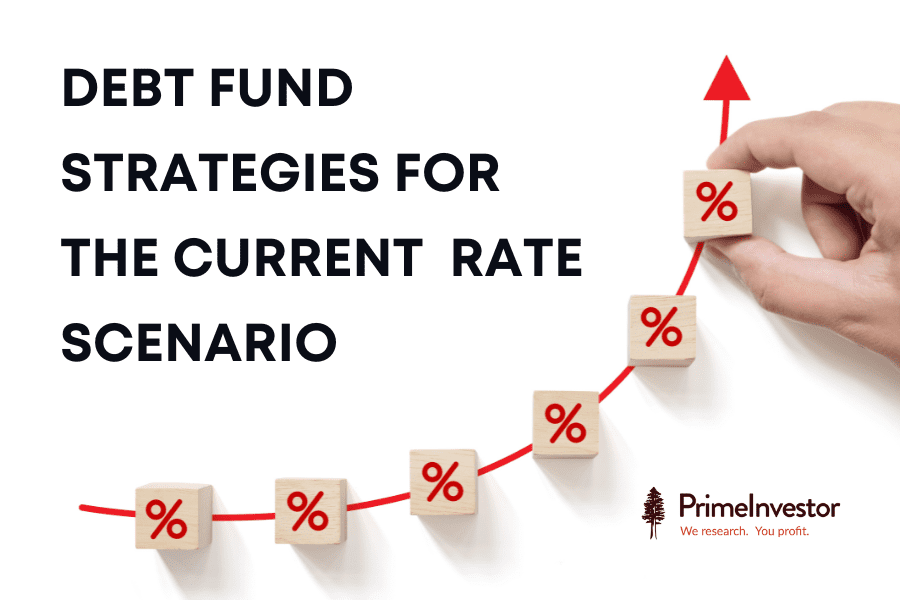The Reserve Bank’s monetary policy on Wednesday served up another repo rate hike of 35 basis points, adding to the 190 basis points through this year. That takes the repo rate to 6.25% from the Covid low of 4%. The key driving factor behind the rapid rate hikes – that of inflation – still remains. The RBI has clearly spelt its commitment to bringing inflation within the target range, even in its latest monetary policy.
But what’s also emerging are signals that the rate hike cycle is drawing closer to the peak. Or, to put it differently, while the RBI has left itself room to raise rates further, the pace and extent of the hikes may not be as blistering as before. From the peak, rates may remain stagnant before eventually shifting back down. This trend is already visible in the yield of 10-year gilt over the past 1.5 months.
In this light, debt fund strategies you have now, to make the most of the current scenario, can be decided based on what you want:
- Buy and hold, to earn from the attractive yields now (called the accrual strategy)
- Take the higher risk and invest in long-term debt funds now, when prices are low, to reap returns when the rate cycle shifts lower (called the duration strategy)

The rate cycle signals
We will give a more detailed outlook on interest rates and debt markets in our 2023 outlook next month – this will be a more overall recommendation on debt opportunities as a whole and not specific to a particular strategy; we’re sticking to debt funds alone in this report. Meanwhile, though, there are a few indicators that point to the rate rise cycle getting into the end-stage.
#1 RBI & inflation indicators
In the latest monetary policy, the RBI continued to stress on the need to bring inflation under control and has aimed to withdraw its accommodative stance to ensure inflation remains within the target. Nor has it changed inflation projections for the rest of the fiscal year or the first quarter of FY-24. It has also revised GDP growth projections marginally lower.
But if all this sounds super-hawkish, there are other trends playing out. One, obviously, is that the quantum of hike dropped from 50 basis points to 35 basis points; this indicates that the sharp earlier increases accounted for the bulk of the rate hikes and further increases can slow.
This apart, the hikes already undertaken need time to take effect on inflation – a factor that had been highlighted in the earlier September policy meeting. That meeting had two members turning cautious on further rapid rate increases, citing the need to watch the impact on both economic growth as well as inflation. The current meeting also had one dissenting voice on hikes, as well as two on withdrawal of accommodative stance. This seems to suggest that the monetary policy committee’s stance is less firmly anchored towards continued increases.
Further, though CPI inflation has been sticky, WPI inflation has begun to cool off which eventually trickles down into consumer inflation. Global commodity prices have corrected and supply chain pressures that were responsible for part of pricey inputs have waned as well. The domestic agricultural outlook has also improved.
This suggests that, while inflation – especially core inflation – is not yet in the RBI’s comfort zone, the weight of the inflation issue has reduced and action may now depend on both incoming data and global factors. The other factor that has been at play are US rates; commentary from the US Fed also appears to suggest a tamer pace of hikes.
Therefore, though there are no explicit signals that the peak rate has been reached, the likelihood of further hikes of the nature we’ve seen thus far stands curtailed. Market reports and economist commentary suggest a further 25-50 basis point increase at most.
#2 Market indicators
Another trend that points towards the rate rise cycle nearing its zenith is yield movements. The bellwether 10-year gilt yield has been shifting downwards in the past few weeks. Bond yields move up during a rising rate cycle and vice versa; since bond markets usually move based on rate expectations and not actual rate action, the falling yield is a sign that markets also do not expect rates to rise much more.
As the chart below shows, the 10-year gilt, after hitting a high of 7.62 mid-year and closing in on that level again last month, has since dropped down to 7.26 levels now. While yields moved slightly higher in the immediate wake of the monetary policy announcement, it settled back lower.
Opportunities in debt funds
It is not possible to perfectly time the rate cycle; it’s best to act when there are more concrete indications over where rates may move. At this juncture, therefore, there are two ways you can play debt funds.
Before we get into these opportunities in debt funds, an important note:
- These strategies are only for any surplus that you wish to invest in debt, or if you’re specifically looking for debt fund options based on the current rate cycle.
- Do not disturb your existing debt fund investments and do not exit for the sake of following such strategies.
- Simply holding on to your current funds will still earn you returns (provided, of course, they are quality funds! Please check the MF Review Tool for our calls on funds).
#1 Buy and hold
This opportunity is for those who would like the steadiness of accrual and who wish to make the most of the current high yields and who have a longer time frame of at least 3 years. For shorter time frames, you have no choice but to stick to categories such as low duration, ultra-short or money market funds.
For longer time frames, one option is to invest in short-duration funds or, if your investment horizon permits, longer-maturity accrual funds such as corporate bond or medium term funds. Yields on these fund categories have significantly improved over the past year (see table below) and can therefore deliver well. Investing in the longer-maturity funds will also benefit should the rate cycle move into a falling cycle down the line.
You can either add to the funds you already hold (if they are Buys in the MF Review Tool) or choose from the Short-Term and Medium-Term categories in Prime Funds.
The other option is to invest in target maturity funds; the recent flood of NFOs in these funds throw up plenty of options. Yields on these funds are similar to that of other debt fund categories above, and give you the advantage of locking into these strong yields. Investments here are best done through lumpsums now rather than SIPs in order to lock into the higher yields. Do bear in mind that these target maturity funds are best aligned with your own investment timeframe as they will mature at the end and money returned to you.
Within target maturity funds, our recommendation is that you go for funds that:
- Have a maturity of 3-6 years – the maturity-yield payoff here is better in these timeframes than the very long timeframes. To take more up-to-date yields, the Bharat Bond series offers perspective (as they are the only funds that declare current yields and not end-of-month). The 2027 gilt Bharat Bond currently has a yield of 7.47%; the 2030-2032 Bharat Bond has a yield of 7.51-7.54%. The spread between the 2032 and the 2027 has also narrowed from earlier.
- Invest in SDLs, either standalone or along with PSU bonds – SDLs offer a better yield that plain gilts and are not much riskier either. For example, based on October data, the average yields of 2027/2028 gilt-only TMFs were around 7.46. SDL and SDL-PSU TMFs were between 7.52 to 7.57%.
The list of funds that meet the above criteria is below; we have removed funds with an AUM of less than Rs 100 crore. You can go for the funds with lower expense ratios. There isn't much of a difference in these fund strategies, just that the ones with SDL can give marginally higher yield. Please note that this is not an exhaustive list and given the spate of NFOs, there could well be other funds that come up.
#2 Play duration
A few months ago, when long-term yields were at highs and returns at lows, we had recommended investing in constant maturity funds through short-running SIPs. This recommendation was intended to make the most of the ‘low’ in the category – similar to buying equity when markets are down – and to hold for the long term.
Now, we are still making the case for constant maturity funds but with a difference. Here is our recommendation:
- As explained above, rates may not move much higher from here – rates are then likely to hold steady for a period but will eventually have to move down. When that turn happens, there are opportunities to make higher returns through bond price appreciation. Therefore, the scenario now appears attractive to get into a duration play by investing at high yields and lower bond prices and book profits down the line.
- This opportunity is best played through very long-term maturity funds of around 10 years –constant maturity gilt funds or 10-year gilt-only target maturity funds. We do not recommend other gilt funds here as there is no control over what maturity these funds will maintain.
- Lumpsum investments are preferrable to SIPs; you can at best stagger lumpsums over the next 2-3 months.
This strategy needs a higher risk appetite as it involves a bet on bond price movements. It also needs you to be vigilant and book profits when returns come in, which also means that you cannot really earmark it towards a particular goal. This holds even if you invest in a TMF; the call here is not to hold to maturity but to book profit or exit on a bond price rally. Note that the rate cycle heading lower is not a near-term call; you will have to hold for a longer period.
An indicator that you can track is the return you earn on the fund. If the compounded annual return since your investment is in single digits or double digits, it may be time to begin booking profits. For example, gilt fund 1-year returns in 2019 when the rate cycle began to fall shot all the way up to 16%.
Our recommendation in constant maturity gilt funds is in the Very Long Term section of Prime Funds. For target maturity funds, the table below lists those with a 9-10 year maturity that invest only in gilts.
To summarise, while the RBI has its sights firmly set on bringing inflation under control and has the leeway to raise rates further, the bulk of the rise is now behind us. This offers opportunities if you’re looking for specific debt fund strategies to take advantage of the current rate scenario. If you do not have a surplus to invest now, there’s no action that you need to take. Simply continue to hold your current debt fund investments; portfolio yields are on the uptick after a years-long low phase which will begin to show up in your returns.




30 thoughts on “Debt fund strategies for the current rate scenario”
What is your opinion on SDL target debt fund maturing on 2033 (Example: UTI CRISIL SDL Maturity April 2033 Index Fund Direct – Growth)? You are recommending SDL target debt fund maturing in 5-6 years. Why not longer duration?
It’s explained in the post – the yields in the 5-7 year timeframe offer a better proposition. Please see the first bullet point under Buy & Hold. – thanks, Bhavana
Ok thanks. if the horizon is long term, between Corp bonds and TDF which one is a better option to invest. If possible a comparision between the two would help, scenarios in which to consider TDF and Corp bonds.
It’s entirely up to what you wish to do – the TMF will bring you a good degree of certainty in what returns you will get, but if the maturity is shorter than your timeframe, then you will have to reinvest the proceeds at that point. There’s no return comparison on past performance that can be made as target maturity funds are a new concept. – thanks, Bhavana
“An indicator that you can track is the return you earn on the fund. If the compounded annual return since your investment is in single digits or double digits, it may be time to begin booking profits.”
What does that line mean? Its kind of saying you stay invested only if there are triple digit returns – which I guess is not what you are actually intending to convey.
In a duration call, one needs to exit when yields drop as the rate cycle shifts lower. This reflects in the returns of the fund which goes up. So, an indicator that can signal that yields are down and it can be time to start booking profits is the return – ie when returns start to show up well, it means that bond prices are rising in response to the rate cycle – thanks, Bhavana
Hello Ma’am.
You mention in your article that its better to invest lump sum or max 2-3 months in 10 year gilts “Constant Maturity”. According to past article there was a mention that when the investment horizon is long then constant maturity funds can be made part of the debt portfolio as SIP.
I am slightly confused because of these two instructions. What am I missing?
Thanks
Kishan
A fund can be used in different ways. Yes, constant maturity funds can be used for debt portions of long-term portfolios – as we’ve mentioned in the article, we had also alerted on the opportunity in constant maturity funds for long-term holdings a few months ago.
However, one can also make returns in debt funds by playing the interest rate cycle – essentially investing when yields are high (and bond prices low) and exiting when yields fall and bond prices rise. It is this strategy that we have issued this time. For this, constant maturity funds are the best fits – most funds with long maturities are good ways to play duration, but the maturity profile and the stable maturity in constant maturity funds make them very suitable.
-thanks, Bhavana
Hi, I have sizeable amount in 3 Dynamic Bond Funds (I know too many) with average Macaulay duration around 4-5yrs, does it make sense to redeem them and switch to 10 Year Gilts ?
As mentioned in the post, we don’t recommend exiting funds just for the sake of this strategy.
A dynamic bond fund is very different from a 10-year gilt fund. The dynamic fund will be shifting its portfolio based on the rate cycle, can take different duration calls and not necessarily 10 year, and can hold to high-coupon accrual. All this makes the risk-return profile different – and each dynamic bond fund will differ from the other. The 10-year gilt call will be higher risk. This apart, if you have earmarked the dynamic bond funds towards a portfolio goal, then substituting it with a duration call is not really ideal – duration is not a buy-and-hold strategy.
So you can take a call – if your dynamic bond allocation is indeed high, shift some to accrual funds. Or if you do not mind the higher risk or you don’t particularly need the fund for any near-term goal, then you can shift some to the 10-year gilt call we have given. – thanks, Bhavana
Will you be giving a call , when to exit these TMF.
Depends on which TMF you go for…but in general, yes, we will alert on booking profit in the duration call. Please note that it is not a near-term call and will be given only when the rate cycle shifts eventually. This is also why we have given return indicators you can watch for. – thanks, Bhavana
Hi Mam,
On the duration play, will we be getting any profit booking call in the future.
Generally speaking, yes, we will alert on booking profit in the duration call. But do note that we do not expect rates to go down soon – all we have said is that the rising cycle is peaking which makes it a good buying opportunity. Rates can stagnate for a good while before turning down so it requires a long-term horizon. This is also why we have given return indicators you can watch for. – thanks, Bhavana
Thank Bhavana, useful article. If one has large surplus with long term time frame 5years+ what would be the best divide (%wise) between the Accrual and Duration strategy you have mentioned. Thanks.
Depends on your risk appetite, how much you’re investing in proportion to your portfolio, and whether you need the money for a specific goal. Typically, if your risk appetite is lower then invest more in accrual funds and keep a low allocation to the duration call. Else, you can go higher in duration as well. – thanks, Bhavana
Hi Madam,
How about 10 year floating rate bonds. is it good to hold (or) exit?
Do you mean the RBI Taxable Floating Rate bonds? They are more useful for income generation, not as calls on rate cycles so they will not work here. Otherwise, if you want to generally ride the rate cycle where it goes, you can invest in floating rate funds or even in short-duration funds. – thanks, Bhavana
Hi, What is your view on Corporate Bond Funds at this point? There is no mention of them in the article. The YTMs are attractive there too. Also the current prime rates are 4-5 for some of them.
We have mentioned it – please see the Buy and Hold subhead; you can invest in these funds and portfolio YTMs have markedly improved. – thanks, Bhavana
Comments are closed.